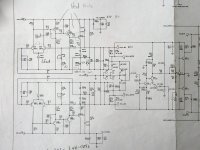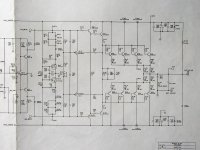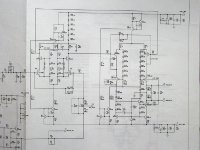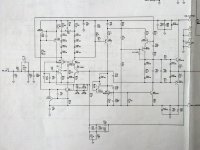I know, I know, I could properly buy a Mark Levinson 23.5 for cheaper and perfectly made, but I think it could be fun to build the amp myself from schematics. The project is not to get anything better or equal, but simply the fact that building is fun! 
But is it even possible, I have found this document, but is it enough to a complete build?
(please ignore that the component values is impossible to read)
https://www.audioservicemanuals.com...1369889-mark-levinson-27-5-pwr-service-manual
But is it even possible, I have found this document, but is it enough to a complete build?
(please ignore that the component values is impossible to read)
https://www.audioservicemanuals.com...1369889-mark-levinson-27-5-pwr-service-manual
I don't know about ML products that much. The 23.5 looks like a nice beefy dual mono class A amp if this picture below is correct. I like the use of space they did there. Probably not the best example since it looks like the pcb next to the torroid on the right burnt up.

I tried looking for a schematic but struck out. Closest one I could find is for the 23:
https://elektrotanya.com/PREVIEWS/63463243/23432455/mark-levinson/mark-levinson_23.pdf_1.png
https://elektrotanya.com/PREVIEWS/63463243/23432455/mark-levinson/mark-levinson_23.pdf_2.png
I tried looking for a schematic but struck out. Closest one I could find is for the 23:
https://elektrotanya.com/PREVIEWS/63463243/23432455/mark-levinson/mark-levinson_23.pdf_1.png
https://elektrotanya.com/PREVIEWS/63463243/23432455/mark-levinson/mark-levinson_23.pdf_2.png
Last edited:
I just saw the schematic as a single PDF file here: https://www.diyaudio.com/community/threads/mark-levinson-23-5-bias-procedure.255242/#post-4236569 . It appears to be a little less blurry if that helps. Is this amp class AB? I see it does 200W @ 8 ohm, 400W @ 4 ohm and can be bridged to get up to 800W @ 8ohm (in mono) 😯 I also see that used this thing still gets around $2500. So If you could get someone to help with a PCB, then you should be able to build for $500 to $600 I think?
Last edited:
Thanks, yes, it helps a lot. The price sounds great, but you properly have to add the transformers, capacitors and the cabinet to thatI just saw the schematic as a single PDF file here: https://www.diyaudio.com/community/threads/mark-levinson-23-5-bias-procedure.255242/#post-4236569 . It appears to be a little less blurry if that helps. Is this amp class AB? I see it does 200W @ 8 ohm, 400W @ 4 ohm and can be bridged to get up to 800W @ 8ohm (in mono) 😯 I also see that used this thing still gets around $2500. So If you could get someone to help with a PCB, then you should be able to build for $500 to $600 I think?
I hope to find images of the original boards and place the components in something similar.
Do you know who has added notes on the schematic?Here it is.
So If you could get someone to help with a PCB, then you should be able to build for $500 to $600 I think?
Perhaps a suitable case + heatsinks cost that much. Or the custom ordered transformers alone. If you want a similar amp NOTHING beats buying second hand and spending a few hundred on non-negotiable updates.
You are completely correct but also, nothing beats the fun in taking a schematic from an old renowned amp and building it yourself from the ground upPerhaps a suitable case + heatsinks cost that much. Or the custom ordered transformers alone. If you want a similar amp NOTHING beats buying second hand and spending a few hundred on non-negotiable updates.
very interesting starting point concerning the meticulous choice of components by the manufacturer VS a clone with components of the same reference but not specifically chosen.
The most striking example for me (who has experienced it) is to build a clone of naim (at first sight) then with time and the very long reading of the dedicated thread, learn the "secrets" of this diagram to ultimately discover an amp very different from the first basic clone.
I do not know enough "internally" the ML to give an opinion but I still want to discuss "clone VS original manufacturer"
The most striking example for me (who has experienced it) is to build a clone of naim (at first sight) then with time and the very long reading of the dedicated thread, learn the "secrets" of this diagram to ultimately discover an amp very different from the first basic clone.
I do not know enough "internally" the ML to give an opinion but I still want to discuss "clone VS original manufacturer"
YesDo you mean the 4 images of the circuit in post3?
To me is it a great help if everything is written, particular components, types, values and so on. In this way can I build the circuit and then try to switch out components, try different values and so on, knowing that the original is working and has been used by listeners all over.
If a component is no longer available, do I try to learn about that one component, what matches best and lol, bug you all to insanity by my question number 978.
There is of course lots of things that I stumble upon and maybe will it never work, but hey, it's the journey!
If a component is no longer available, do I try to learn about that one component, what matches best and lol, bug you all to insanity by my question number 978.
There is of course lots of things that I stumble upon and maybe will it never work, but hey, it's the journey!
Everything is still readily available either in original form or as a direct replacement.To me is it a great help if everything is written, particular components, types, values and so on. In this way can I build the circuit and then try to switch out components, try different values and so on, knowing that the original is working and has been used by listeners all over.
If a component is no longer available, do I try to learn about that one component, what matches best and lol, bug you all to insanity by my question number 978.
There is of course lots of things that I stumble upon and maybe will it never work, but hey, it's the journey!
Hans
@FriedMule
Instead of worrying now about availability of components, it would be wise as a first step to get all the circuit diagrams that you will need.
Second step would be to trying to understand what all the various parts are doing, this is not just a simple design.
Third step could be to place everything in LTSpice getting a better feeling for the sensitivity of various components and their values and whether some parts can be “modernised or upgraded”
After having taken all these steps succesfully, it’s time to start building, if not catastrophy will be your part.
Just my 2 cents.
Hans
Instead of worrying now about availability of components, it would be wise as a first step to get all the circuit diagrams that you will need.
Second step would be to trying to understand what all the various parts are doing, this is not just a simple design.
Third step could be to place everything in LTSpice getting a better feeling for the sensitivity of various components and their values and whether some parts can be “modernised or upgraded”
After having taken all these steps succesfully, it’s time to start building, if not catastrophy will be your part.
Just my 2 cents.
Hans
You are right, my reason for my answer above was just to tell that I prefer a schematic with as much information and written components, that if they do not exist, can I always just look for alternative when it comes to that point. 
The problem with LTSpice is that it is a very big circuit and I do not bother to draw it several times in different programs.
The problem with LTSpice is that it is a very big circuit and I do not bother to draw it several times in different programs.
I am assuming that picture 1 and 2 in post 3 is the amplifier circuit, but I do not feel so sure about picture 3 and 4, to me does it look like two separate circuits, connected by a few traces?Second step would be to trying to understand what all the various parts are doing, this is not just a simple design.
Hans
Could you maybe please try to identify them?
There you go, wrong.
Picture one the regulated power supply and two is mainly the output stage.
But as mentioned before, all belonging to the 27.5.
So before answering your questions, what do you want to build, the 27.5 or the 23.5.
It would not be bad to select the 27.5 because it is simpler and well documented, including with PCB layout.
Hans
Picture one the regulated power supply and two is mainly the output stage.
But as mentioned before, all belonging to the 27.5.
So before answering your questions, what do you want to build, the 27.5 or the 23.5.
It would not be bad to select the 27.5 because it is simpler and well documented, including with PCB layout.
Hans
- Home
- Amplifiers
- Solid State
- Build the Mark Levinson 23.5 from schematic?



